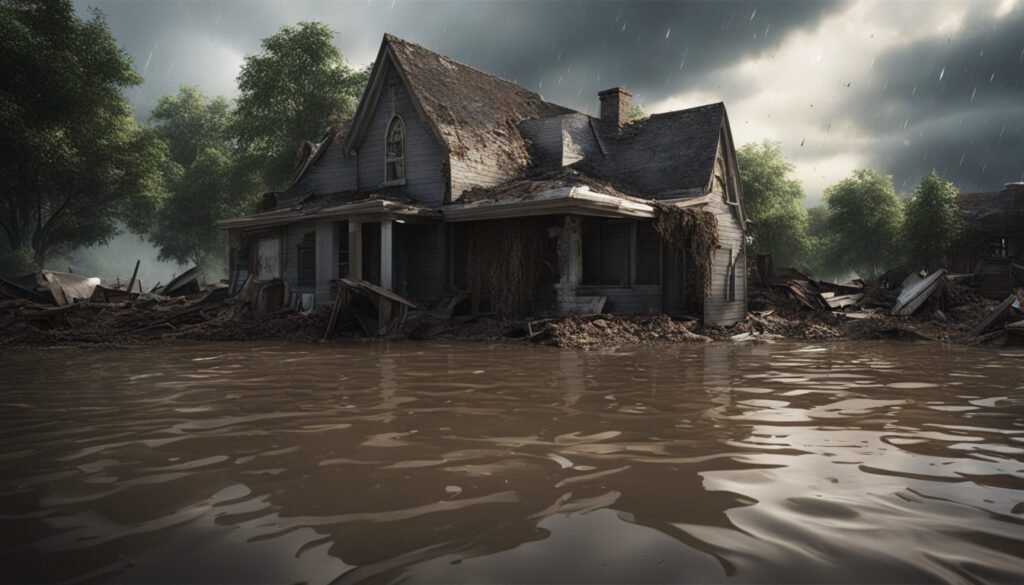Floods happen more often than any other natural disaster in the United States. They impact millions of people every year.
Having a detailed checklist after a flood is key for safe and efficient cleaning. This checklist helps minimize damage, ensure safety, and fix your property. With it, you can tackle flood cleanup confidently.
Key Takeaways:
- A flood cleanup checklist is essential to minimize damage and address safety concerns.
- Inspect the building for structural damage, gas leaks, and electrical hazards before entering.
- Turn off all electrical and gas systems and use proper personal protective equipment.
- Hiring professional flood cleanup services ensures a safe and efficient cleanup process.
- Thoroughly dry off and clean appliances and equipment to prevent further damage.
Safety Precautions during Flood Cleanup
The first thing in flood cleanup is making sure everyone is safe. Check the building for any structural damage, gas leaks, or electrical risks before going in. Always turn off all electrical and gas systems. And wear the right protective gear to guard against harmful stuff. It’s also key to get professional flood cleanup services to ensure the process is safe and done right.
When fixing water damage, always think safety first. Here are some important safety tips to remember:
- Inspect the building: Look over the building carefully for signs of structural problems before entering the flood area. Check for cracks in foundations or walls that look weak. If the building seems unsafe, wait for experts to help.
- Check for gas leaks: Floods can cause gas leaks, which might lead to fires or explosions. If you smell gas or think there might be a leak, turn off the gas right away. Open windows and doors to let air in and don’t use anything that could cause a spark.
- Turn off electricity: Water and electricity are a bad mix. Make sure to shut off the electricity at the main breaker before getting near the water. If the breaker is in a flooded spot, don’t try to reach it. Instead, call a professional electrician.
- Protective gear: Always wear the proper Personal Protective Equipment (PPE) like rubber gloves, boots, goggles, and a mask. PPE helps protect you from getting sick from bacteria, mold, and other bad stuff in the floodwater.
Always better to go with professional help for emergency flood cleanup. They have the skills, gear, and experience to clean up safely and effectively.
Equipment and Appliance Cleanup
Floods can damage appliances and equipment a lot, especially if they were on during the flood. It is vital to clean and fix these items properly to ensure they are safe and work right.
First, always think of safety when cleaning up. Before you touch any appliance or equipment hit by the flood, turn off all electricity and gas. This step helps avoid accidents or electrical dangers.
With safety measures set, check the damage and see which items can be saved. Items made of stainless steel, glass, or plastic might be okay if the flood didn’t hit them too hard.
Make sure items are dry before you begin to clean. Use towels or something that soaks up water to dry them. Then, clean with a disinfectant to kill bacteria or harmful stuff from the flood.
Note: Be careful with items touched by floodwater as they can have harmful germs. It’s a good idea to wear gloves and masks for protection.
Check each item for mold, rust, or wear and tear. If you see any of these, it’s safer to throw the item away. It might not be safe or possible to fix. Moldy items need careful handling to avoid spreading mold spores.
For items you can save, clean them as the maker suggests. Make sure to follow any special cleaning instructions to keep the item in good shape and working well.
“Proper cleaning and drying methods are key to avoid more damage and keep restored items safe.”
Tips for Equipment and Appliance Cleanup:
- Clean and disinfect all surfaces of the appliances and equipment.
- Thoroughly dry off the items before proceeding with the cleaning process.
- Inspect for mold, rust, or deterioration and discard items that cannot be salvaged.
- Follow manufacturer’s instructions for cleaning and maintenance.
- Wear appropriate personal protective equipment when handling flood-affected items.
| Item | Status |
|---|---|
| Refrigerator | Salvageable |
| Television | Discard |
| Washing Machine | Salvageable |
| Computers | Discard |
| Microwave | Salvageable |
Cleaning and Restoration Techniques
After the floodwater disappears, it’s key to clean and fix your floors, walls, and furniture. This avoids more harm. A checklist for flood damage restoration helps you clean up right.
Start by getting rid of any water left using suction devices. This stops mold and kills germs in the water. Good airflow is vital to dry the wet areas well.
Next, check, cleanse, and dry your furniture well. Clean items you can save with a disinfectant. Make sure they’re totally dry to stop mold from forming later on.
When everything’s dry, look at your floors and walls for damage. They might need big repairs. Get help from experts to make sure you’re using the right methods. This helps fix your place right and avoids future problems.


